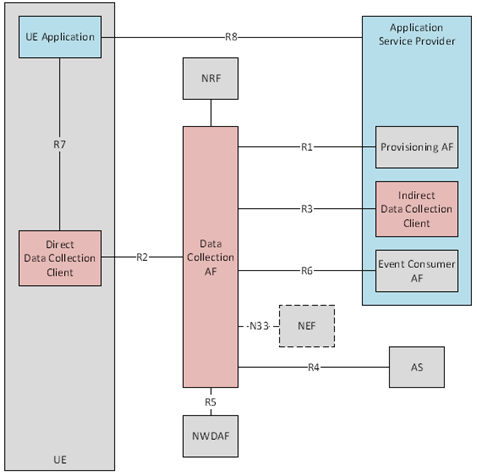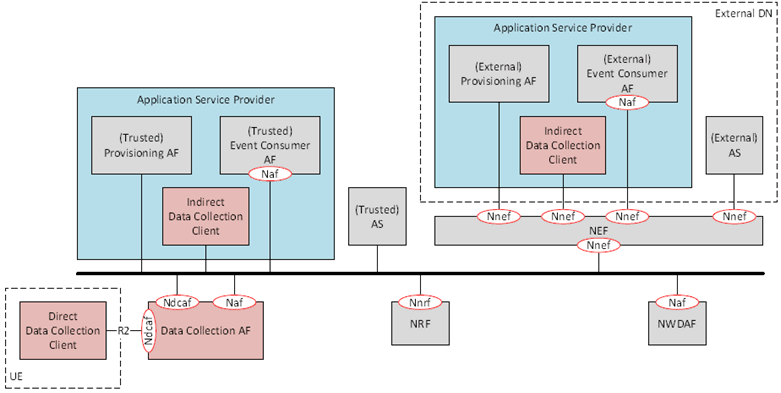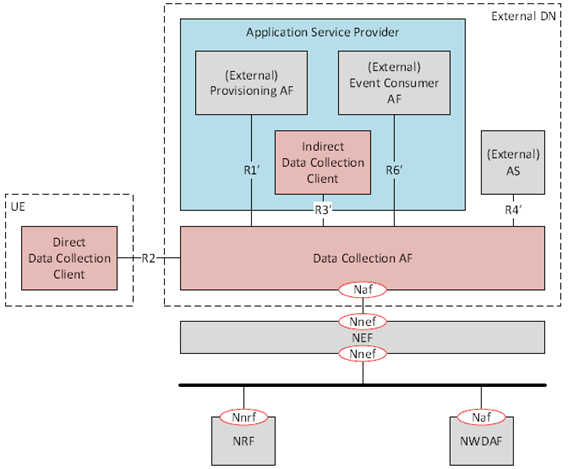Content for TS 26.531 Word version: 17.1.0
4 Reference architecture for data collection and reporting
4.1 General
4.2 Functional entities for data collection and reporting
4.3 Reference points for data collection and reporting
4.4 Service-based architecture for data collection and reporting
...
...
4 Reference architecture for data collection and reporting p. 7
4.1 General p. 7
Clause 6.2.8 of TS 23.288 envisages a set of high-level procedures by which data is collected by a Network Data Analytics Function (NWDAF) from UE Application(s) via an intermediary Application Function. This clause defines a generic reference architecture for data collection and reporting that satisfies those procedures, including the logical functions involved and the logical reference points between them. The intermediary Application Function envisaged in TS 23.288 is here named the Data Collection AF.
It is intended that this reference architecture be instantiated in domain-specific ways to suit the needs of different features of the 5G System. The reference architecture may be instantiated separately in different slices of a network.
The services defined in the present document may be exposed to parties outside the trusted domain via the NEF, as defined in clause 4.7.1.
The Data Collection AF may support CAPIF TS 23.222 to provide APIs to other applications (i.e. API invokers), as defined in clause 4.7.2.
4.2 Functional entities for data collection and reporting p. 8
Figure 4.2-1 below shows the reference architecture for data collection and reporting using reference point notation.

Figure 4.2-1: Reference architecture for data collection and reporting in reference point notation
(⇒ copy of original 3GPP image)
(⇒ copy of original 3GPP image)
The functional entities illustrated in the Figure are described as follows:
1)
Data collection and reporting functionality is provisioned at reference point R1 by a Provisioning AF of the Application Service Provider that may be deployed either inside or outside the trusted domain. The Ndcaf_DataReportingProvisioning service is provided by the Data Collection AF for this purpose.
2)
The Data Collection AF may be deployed inside or outside the trusted domain. It is responsible for managing the provisioning state for data collection and reporting. When its provisioning state changes, the Data Collection AF updates the set of available NF profile(s) in the NRF by invoking the Nnrf_NFManagement service defined in clause 5.2.7.2 of TS 23.502 according to the usage defined in clause 6.2.8.2.2 of TS 23.288 and specified in clause 6.1 of TS 29.510.
Depending on the provisioning information provided by the Application Service Provider (see clause 4.6.2), the Data Collection AF provides a data collection and reporting configuration to the Direct Data Collection Client at reference point R2, to the Indirect Data Collection Client at reference point R3 or to the Application Server (AS) instances at reference point R4, and receives data reports from them respectively at those same reference points.
The Data Collection AF processes received data reports according to processing instructions in its provisioning state. The processing activities include, but are not limited to, reporting format conversion, data normalisation, reporting domain-specific anonymisation of data and (dis)aggregation of data into reports to be exposed as events.
Finally, the Data Collection AF is responsible for exposing processed UE data to event notification subscribers both inside the trusted domain (such as the NWDAF) and outside it (such as the Event Consumer AF in the Application Service Provider). In this role, the Data Collection AF realises the Event Exposure Service as defined in clause 6.2.2.1 of TS 23.288 and as specified in TS 29.517. Subscribers fulfil the role of NF consumers of this service in the service-based architecture [2, 3].
The set of UE data to be collected and exposed by the Data Collection AF is determined by the intersection (1) between its provisioning state provided at R1 and the current set of subscriptions. This is reflected in the data collection and reporting configuration exposed at reference points R2, R3 and R4, and the subscription-driven event notifications sent to consumer entities such as the NWDAF or Event Consumer AF of an Application Service Provider over reference points R5 and R6. The Data Collection AF is responsible for ensuring that access to UE data is controlled according to the rules indicated in its provisioning state.
3)
(1) In the event that provisioning data and subscription data contain similar rules, the permissible information to be exposed by the Data Collection Function shall be governed by the rule with more restrictive semantics.
The Direct Data Collection Client is responsible for collecting relevant data in the UE and for sending data reports to the Data Collection AF via reference point R2 using the Ndcaf_DataReporting service according to a data collection and reporting configuration that it has previously obtained from the Data Collection AF by invoking the same service at reference point R2.
4)
The UE Application is responsible for sharing relevant data with the Direct Data Collection Client via reference point R7. This may be achieved as a combination of application design, application configuration via R8 and/or application configuration via R7.
5)
An Application Service Provider may also collect data from UE Applications via reference point R8 and employ an Indirect Data Collection Client subfunction to then send data reports to the Data Collection AF via reference point R3 by invoking the Ndcaf_DataReporting service according to a data collection and reporting configuration that it has previously obtained from the Data Collection AF by invoking the same service at reference point R3.
6)
Application Server instances (labelled AS) inside or outside the trusted domain may also collect data and report it to the Data Collection AF via reference point R4 by invoking the Ndcaf_DataReporting service, according to a data collection and reporting configuration previously obtained from the Data Collection AF by invoking the same service at reference point R4.
7)
The NWDAF is the primary consumer of processed UE data. This is exposed to the NWDAF by the Data Collection AF in the form of data reporting event notifications via reference point R5 using the Naf_EventExposure service (as specified in TS 29.517) after any processing by the Data Collection AF has been performed according to its provisioned processing instructions.
8)
By means of appropriate data collection and reporting provisioning, certain UE data may also be exposed in the form of data reporting events by the Data Collection AF to an Event Consumer AF residing in the Application Service Provider via reference point R6 using the Naf_EventExposure service defined in clause 5.2.19 of TS 23.502 and specified in TS 29.517.
4.3 Reference points for data collection and reporting p. 11
The purposes of the reference points in the functional architecture defined in clause 4.2 above are as follows:
-
R1 supports the following interactions between a Provisioning AF in the Application Service Provider and the Data Collection AF:
-
Used by the Application Service Provider to provision data collection and reporting in a Data Collection AF instance by means of the Ndcaf_
DataReportingProvisioning service defined in clause 4.4 of the present document (or else the equivalent service exposed by the NEF if the two functions are deployed in different trust domains). The provisioning information specifies what data is to be collected by data collection clients, how it is to be processed by the Data Collection AF and how it is to be exposed to event notification subscribers. A generic provisioning envelope for data collection and reporting is defined in clause 4.6 of the present document, but this is expected to be extended by individual reporting domains.
-
Used by the Application Service Provider to provision data collection and reporting in a Data Collection AF instance by means of the Ndcaf_
-
R2 supports the following interactions between the Direct Data Collection Client in the UE and the Data Collection AF:
-
Used by a Direct Data Collection Client instance to obtain its data collection and reporting configuration from the corresponding Data Collection AF instance by means of the Ndcaf_
DataReporting service defined in clause 4.4 of the present document. A generic data collection and reporting configuration envelope is defined in clause 4.6.3 of the present document, but details of the configuration are specific to individual reporting domains and are specified elsewhere. -
Subsequently used by the Direct Data Collection Client to send reports to its Data Collection AF instance by means of the Ndcaf_
DataReporting service defined in clause 4.4 of the present document. A generic data reporting envelope is defined in clause 4.6.4 of the present document, but details of the reporting format are specific to individual reporting domains and are specified elsewhere.
-
Used by a Direct Data Collection Client instance to obtain its data collection and reporting configuration from the corresponding Data Collection AF instance by means of the Ndcaf_
-
R3 supports the following interactions between the Indirect Data Collection Client in the Application Service Provider Server and the Data Collection AF.
-
Used by an Indirect Data Collection Client instance to obtain its data collection and reporting configuration from the corresponding Data Collection AF instance by means of the Ndcaf_
DataReporting service defined in clause 4.4 of the present document (or else the equivalent service exposed by the NEF if the two functions are deployed in different trust domains). A generic data collection and reporting configuration envelope is defined in clause 4.6.3 of the present document, but details of the configuration are specific to individual reporting domains and are specified elsewhere. -
Subsequently used by the Indirect Data Collection Client in the Application Service Provider server to send data reports to its Data Collection AF instance by means of the Ndcaf_
DataReporting service defined in clause 4.4 of the present document (or else the equivalent service exposed by the NEF if the two functions are deployed in different trust domains). A generic data reporting envelope is defined in clause 4.6.4 of the present document, but details of the reporting format are specific to individual reporting domains and are specified elsewhere.
-
Used by an Indirect Data Collection Client instance to obtain its data collection and reporting configuration from the corresponding Data Collection AF instance by means of the Ndcaf_
-
R4 supports the following interactions between the Application Server (AS) and the Data Collection AF:
-
Used by an AS instance to obtain its data collection and reporting configuration from the corresponding Data Collection AF instance by means of the Ndcaf_
DataReporting service defined in clause 4.4 of the present document (or else the equivalent service exposed by the NEF if the two functions are deployed in different trust domains). A generic data collection and reporting configuration envelope is defined in clause 4.6.3 of the present document, but details of the configuration are specific to individual reporting domains and are specified elsewhere. -
Subsequently used by the AS instance to send data reports to its Data Collection AF instance by means of the Ndcaf_
DataReporting service defined in clause 4.4 of the present document (or else the equivalent service exposed by the NEF if the two functions are deployed in different trust domains). A generic data reporting envelope is defined in clause 4.6.4 of the present document, but details of the reporting format are specific to individual reporting domains and are specified elsewhere.
-
Used by an AS instance to obtain its data collection and reporting configuration from the corresponding Data Collection AF instance by means of the Ndcaf_
-
R5 supports the following interactions between the NWDAF and the Data Collection AF:
-
Used by an NWDAF instance to subscribe to data reporting events exposed by a Data Collection AF instance, according to the Naf_
EventExposure_ procedure defined in clause 5.2.19.2.2 of TS 23.502, as further elaborated in step 3a of clause 6.2.8.2.3 in TS 23.288, and as specified in TS 29.517 (or else the equivalent Nnef_Subscribe EventExposure_ service exposed by the NEF if the two functions are deployed in different trust domains).Subscribe -
Subsequently used by the Data Collection AF to expose data reporting events to the NWDAF, according to the Naf_
EventExposure_ procedure defined in clause 5.2.19.2.4 of TS 23.502, as further elaborated in step 5a of clause 6.2.8.2.3 in TS 23.288, and as specified in TS 29.517 (or else the equivalent Nnef_Notify EventExposure_ service exposed by the NEF if the two functions are deployed in different trust domains).Notify
-
Used by an NWDAF instance to subscribe to data reporting events exposed by a Data Collection AF instance, according to the Naf_
-
R6 supports the following interactions between the Event Consumer AF in the Application Service Provider and the Data Collection AF:
-
Used by an Event Consumer AF instance to subscribe to data reporting events exposed by the Data Collection AF, according to the Naf_
EventExposure_ procedure defined in clause 5.2.19.2.2 of TS 23.502 and specified in TS 29.517 (or else the equivalent Nnef_Subscribe EventExposure_ service exposed by the NEF if the two functions are deployed in different trust domains).Subscribe -
Subsequently used by the Data Collection AF to expose data reporting events to the Event Consumer AF according to the Naf_
EventExposure_ procedure defined in clause 5.2.19.2.4 of TS 23.502 and specified in TS 29.517 (or else the equivalent Nnef_Notify EventExposure_ service exposed by the NEF if the two functions are deployed in different trust domains).Notify
-
Used by an Event Consumer AF instance to subscribe to data reporting events exposed by the Data Collection AF, according to the Naf_
- R7 is a client API offered by the Direct Data Collection Client to the UE Application.
- R8 supports data collection and reporting interactions between the UE Application and the Application Service Provider server.
4.4 Service-based architecture for data collection and reporting p. 13
Figure 4.4-1 below shows the reference architecture for data collection and reporting in service-based architecture notation. It depicts the case where the Data Collection AF is deployed inside the trusted domain, while the Application Service Provider and the AS may be deployed independently either inside or outside the trusted domain.

Figure 4.4-1: Reference architecture for data collection and reporting in service-based architecture notation when the Data Collection AF is deployed in the trusted domain
(⇒ copy of original 3GPP image)
(⇒ copy of original 3GPP image)
The following service-based APIs are used in connection with data collection and reporting:
1)
Figure 4.4-2 depicts the case where the Data Collection AF is instead deployed outside the trusted domain, along with the Application Service Provider and the (external) AS. In this case, the subfunctions of the Application Service Provider and the (external) AS do not interact with the Data Collection AF via the 5G System service bus. The Ndcaf service is therefore not required in such deployments. The interactions at the relevant reference points are outside the scope of 3GPP and are depicted as R1', R3', R4' and R6' to reflect this.
The Ndcaf_DataReportingProvisioning service is provided by the Data Collection AF. It is defined by the present document and is specified in TS 26.532. This service is used by Provisioning AF instances to provision data collection and reporting in the Data Collection AF.
2)
The Nnrf_NFManagement service is provided by the NRF. It is defined in clause 5.2.7.2 of TS 23.502 and specified in clause 6.1 of TS 29.510. This service is used by the Data Collection AF to register an available NF profile with the NRF for each set of data collection and reporting provisioning information held by the former.
3)
The Ndcaf_DataReporting service is provided by the Data Collection AF. It is defined by the present document and is specified in TS 26.532.
4)
- This service is used by the Direct Data Collection Client, by the Indirect Data Collection Client in the Application Service Provider server and by AS instances to obtain their data collection and reporting configuration from the Data Collection AF.
- Subsequently, this service is used by the Direct Data Collection Client, by the Indirect Data Collection Client and by AS instances to send data reports to the Data Collection AF.
The Naf_EventExposure service is provided by the Data Collection AF. It is defined in clause 5.2.19.2 of TS 23.502 and TS 23.288, and is specified in TS 29.517.
- Used by the NWDAF to subscribe to data reporting events exposed by the Data Collection AF and subsequently used by the Data Collection AF to notify these events to the NWDAF, as described in clause 6.2.2.2 or 6.2.2.3 (as appropriate) of TS 23.288.
- Used by an Event Consumer AF in the Application Service Provider server to subscribe to data reporting events exposed by the Data Collection AF and subsequently used by the Data Collection AF to notify these events to the Application Service Provider server, as described in clause 6.2.2.2 or clause 6.2.2.3 (as appropriate) of TS 23.288.

Figure 4.4-2: Reference architecture for data collection and reporting in service-based architecture notation when the Data Collection AF is deployed outside the trusted domain
(⇒ copy of original 3GPP image)
(⇒ copy of original 3GPP image)